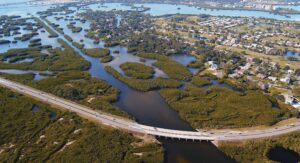New insight on effective solutions

Florida mangroves. Courtesy, National Oceanic and Atmospheric Administration
In my many years in disaster insurance and recovery, I’ve witnessed the wrath of Mother Nature and learned that while you cannot fight her, you can and should prepare for her, and that often nature herself offers among the best defenses from natural disasters. A new report from The National Wildlife Federation and Allied World Insurance looks at natural systems such as reefs, wetlands, and forests, and their ability to reduce damage from disasters such as hurricanes, floods, and wildfires.
The Protective Value of Nature summarizes the increasing body of scientific research over the past two decades – both empirical and model-based – that has improved our ability to evaluate and quantify the protective performance of natural infrastructure. The report offers evidence it says suggests that both natural and nature-based approaches by man for hazard mitigation can be equally or more effective than conventional structural approaches, and are often more cost-effective, too.
“Since healthy, intact ecosystems are often adapted to natural disturbances such as floods and wildfires, they may have the capacity to withstand or recover from extreme weather- and climate-related hazards and adjust to ongoing environmental changes. Conventional structural approaches (i.e., “gray infrastructure”), on the other hand, often require ongoing maintenance, and may need costly repairs when they fail or are damaged,” according to the study.
The report covers risks and natural infrastructure improvements that can make a significant difference in mitigating the specific hazards of inland flooding, coastal storm surge, wildfires, and extreme heat and drought. In Florida, for example, native mangroves play an important role in protecting our coastlines. The research shows that mangroves reduced peak storm surge height by as much as three inches per half mile during hurricanes Charlie and Wilma, which can add up over the space and distance of the surge.
The report offers key policy recommendations in the following areas:
- Protect and restore existing features providing natural defenses
- Mainstream use of natural infrastructure across sectors
- Improve risk assessment and encourage smart development
- Dramatically scale up investments in community resilience and supporting research
In addition to lowering risks, the report points out that natural infrastructure offers additional benefits to society, from provision of food and clean water for people and habitat for fish and wildlife, to recreational opportunities, and cultural and spiritual fulfillment.
LMA Newsletter of 6-22-20

